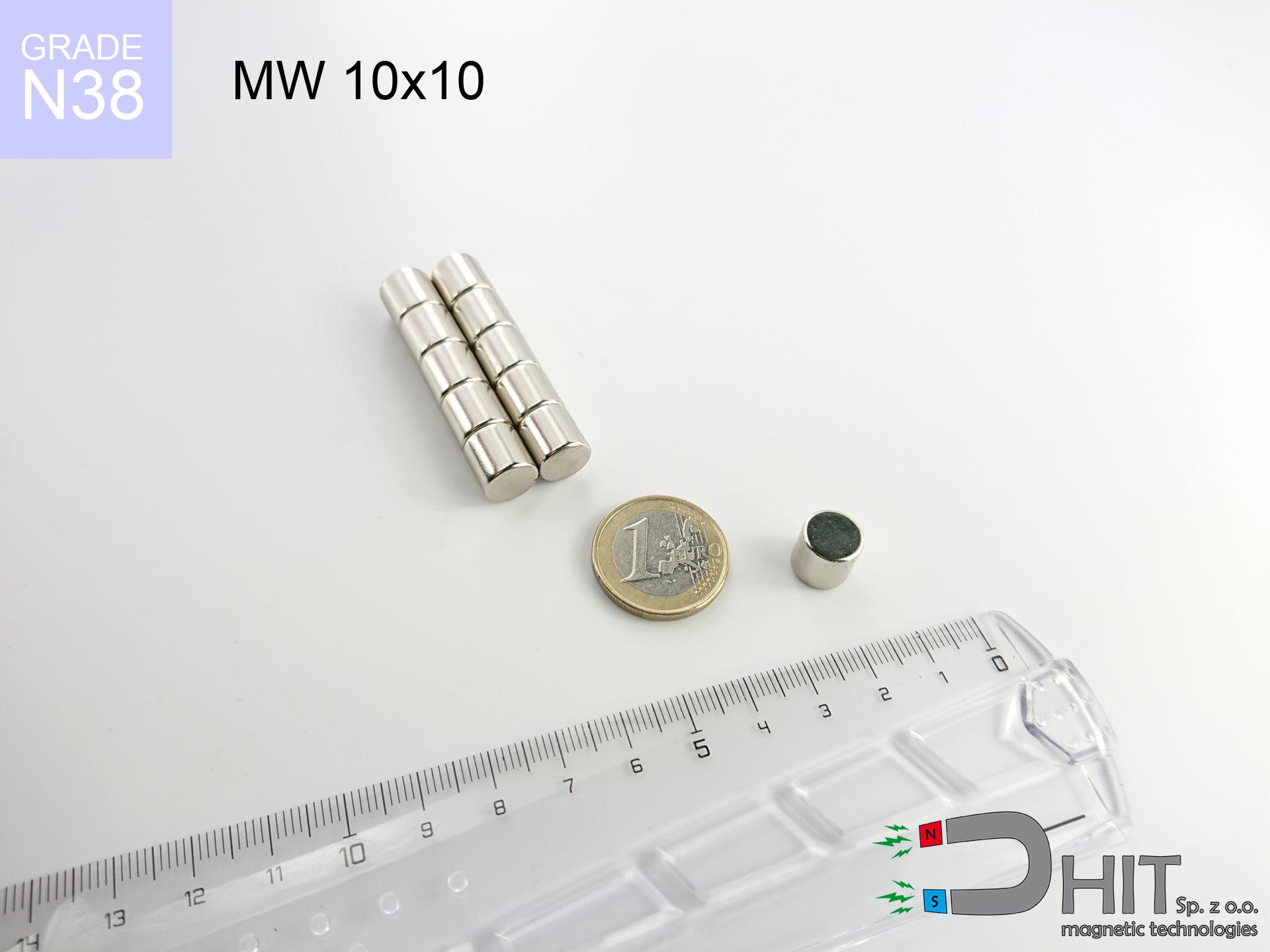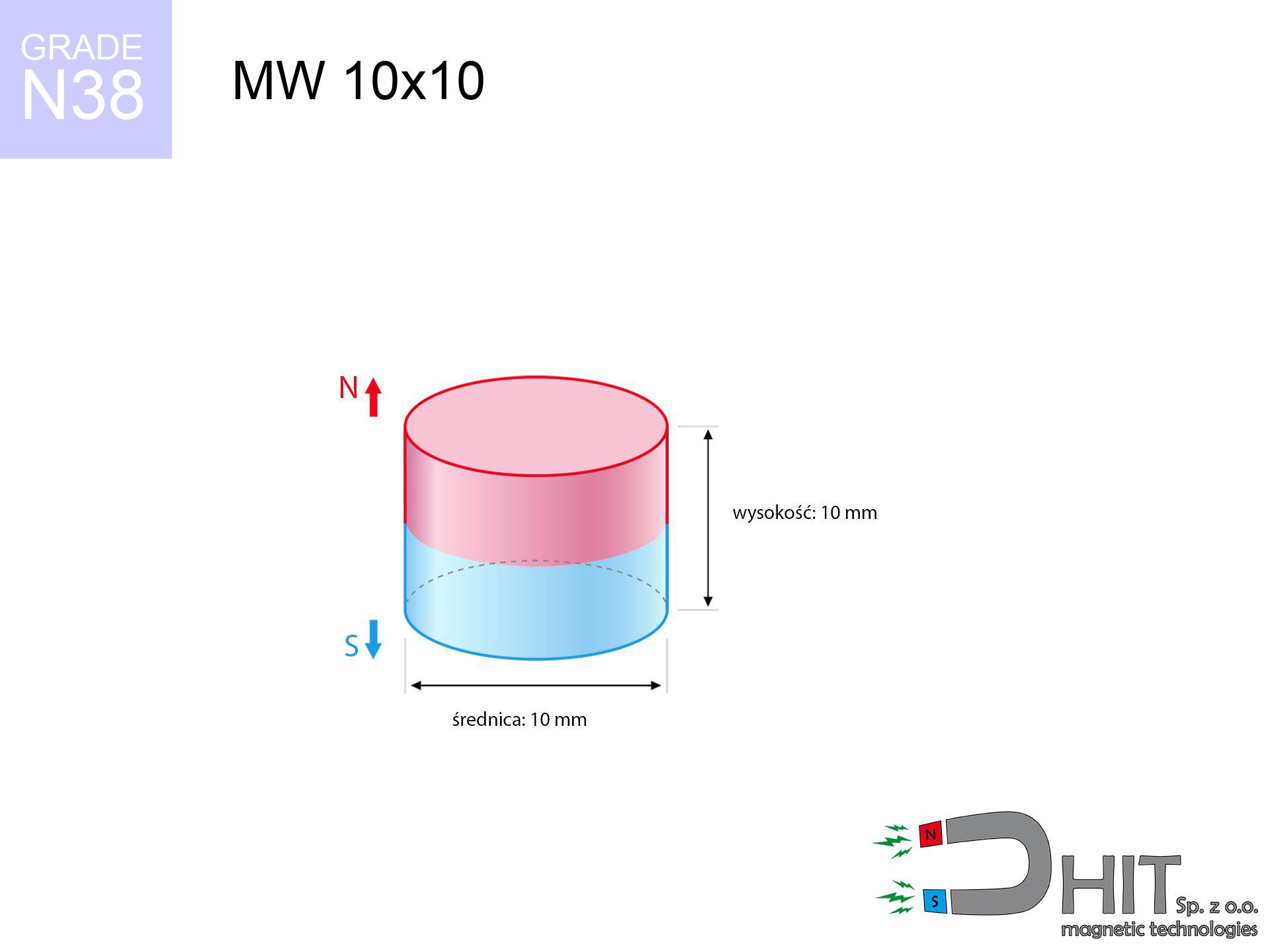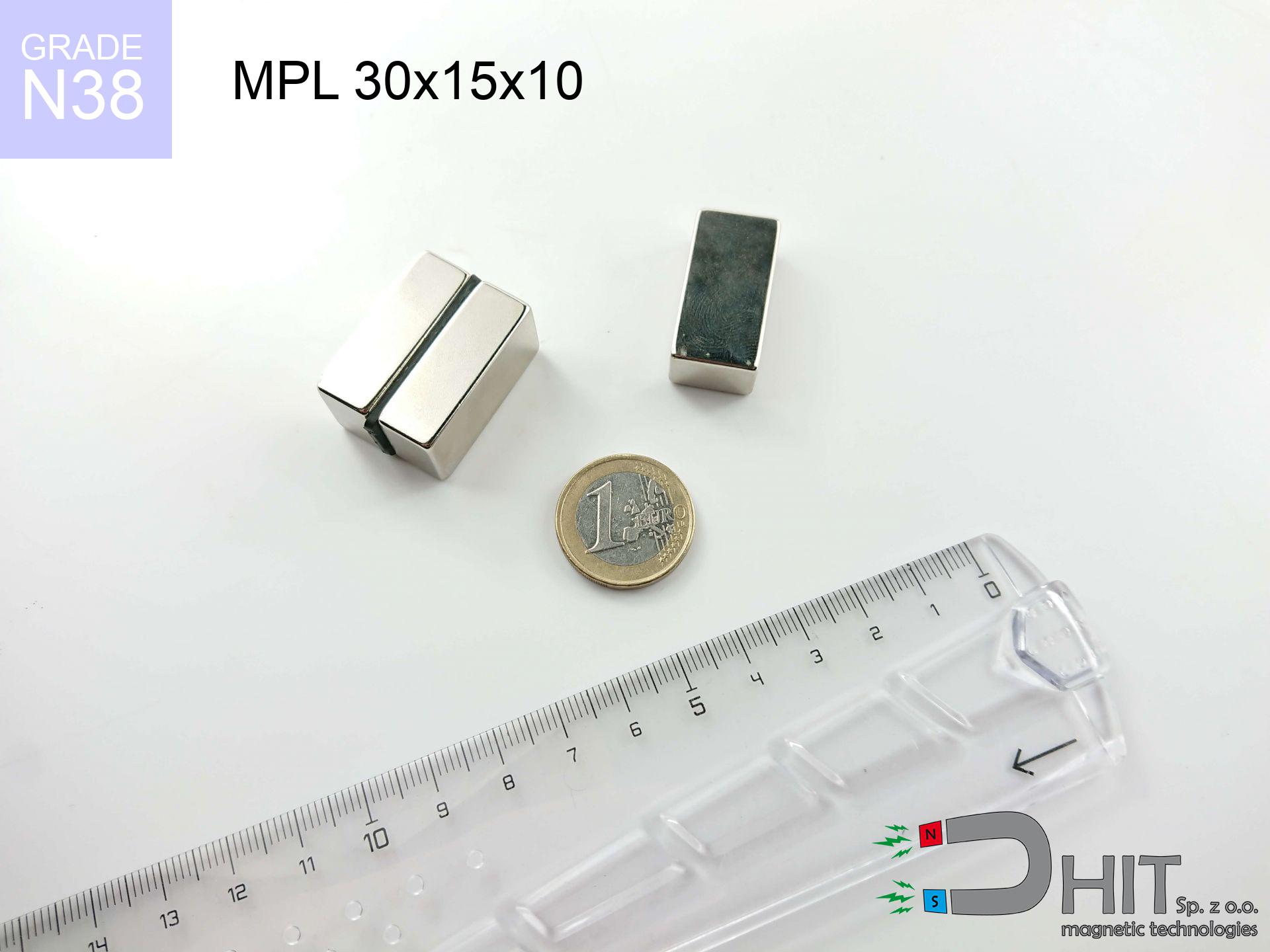MW 10x10 / N38 - cylindrical magnet
cylindrical magnet
Catalog no 010004
GTIN/EAN: 5906301810032
Diameter Ø
10 mm [±0,1 mm]
Height
10 mm [±0,1 mm]
Weight
5.89 g
Magnetization Direction
↑ axial
Load capacity
3.18 kg / 31.15 N
Magnetic Induction
553.84 mT / 5538 Gs
Coating
[NiCuNi] Nickel
4.31 ZŁ with VAT / pcs + price for transport
3.50 ZŁ net + 23% VAT / pcs
bulk discounts:
Need more?
Contact us by phone
+48 22 499 98 98
otherwise get in touch by means of
contact form
through our site.
Lifting power as well as structure of a magnet can be analyzed using our
online calculation tool.
Same-day processing for orders placed before 14:00.
Physical properties - MW 10x10 / N38 - cylindrical magnet
Specification / characteristics - MW 10x10 / N38 - cylindrical magnet
| properties | values |
|---|---|
| Cat. no. | 010004 |
| GTIN/EAN | 5906301810032 |
| Production/Distribution | Dhit sp. z o.o. |
| Country of origin | Poland / China / Germany |
| Customs code | 85059029 |
| Diameter Ø | 10 mm [±0,1 mm] |
| Height | 10 mm [±0,1 mm] |
| Weight | 5.89 g |
| Magnetization Direction | ↑ axial |
| Load capacity ~ ? | 3.18 kg / 31.15 N |
| Magnetic Induction ~ ? | 553.84 mT / 5538 Gs |
| Coating | [NiCuNi] Nickel |
| Manufacturing Tolerance | ±0.1 mm |
Magnetic properties of material N38
| properties | values | units |
|---|---|---|
| remenance Br [min. - max.] ? | 12.2-12.6 | kGs |
| remenance Br [min. - max.] ? | 1220-1260 | mT |
| coercivity bHc ? | 10.8-11.5 | kOe |
| coercivity bHc ? | 860-915 | kA/m |
| actual internal force iHc | ≥ 12 | kOe |
| actual internal force iHc | ≥ 955 | kA/m |
| energy density [min. - max.] ? | 36-38 | BH max MGOe |
| energy density [min. - max.] ? | 287-303 | BH max KJ/m |
| max. temperature ? | ≤ 80 | °C |
Physical properties of sintered neodymium magnets Nd2Fe14B at 20°C
| properties | values | units |
|---|---|---|
| Vickers hardness | ≥550 | Hv |
| Density | ≥7.4 | g/cm3 |
| Curie Temperature TC | 312 - 380 | °C |
| Curie Temperature TF | 593 - 716 | °F |
| Specific resistance | 150 | μΩ⋅cm |
| Bending strength | 250 | MPa |
| Compressive strength | 1000~1100 | MPa |
| Thermal expansion parallel (∥) to orientation (M) | (3-4) x 10-6 | °C-1 |
| Thermal expansion perpendicular (⊥) to orientation (M) | -(1-3) x 10-6 | °C-1 |
| Young's modulus | 1.7 x 104 | kg/mm² |
Engineering simulation of the product - data
These data are the direct effect of a physical analysis. Values were calculated on algorithms for the material Nd2Fe14B. Operational parameters might slightly deviate from the simulation results. Please consider these calculations as a supplementary guide for designers.
Table 1: Static force (force vs distance) - characteristics
MW 10x10 / N38
| Distance (mm) | Induction (Gauss) / mT | Pull Force (kg/lbs/g/N) | Risk Status |
|---|---|---|---|
| 0 mm |
5534 Gs
553.4 mT
|
3.18 kg / 7.01 lbs
3180.0 g / 31.2 N
|
medium risk |
| 1 mm |
4428 Gs
442.8 mT
|
2.04 kg / 4.49 lbs
2036.1 g / 20.0 N
|
medium risk |
| 2 mm |
3420 Gs
342.0 mT
|
1.21 kg / 2.68 lbs
1214.8 g / 11.9 N
|
weak grip |
| 3 mm |
2597 Gs
259.7 mT
|
0.70 kg / 1.54 lbs
700.2 g / 6.9 N
|
weak grip |
| 5 mm |
1498 Gs
149.8 mT
|
0.23 kg / 0.51 lbs
232.9 g / 2.3 N
|
weak grip |
| 10 mm |
469 Gs
46.9 mT
|
0.02 kg / 0.05 lbs
22.9 g / 0.2 N
|
weak grip |
| 15 mm |
198 Gs
19.8 mT
|
0.00 kg / 0.01 lbs
4.1 g / 0.0 N
|
weak grip |
| 20 mm |
101 Gs
10.1 mT
|
0.00 kg / 0.00 lbs
1.1 g / 0.0 N
|
weak grip |
| 30 mm |
36 Gs
3.6 mT
|
0.00 kg / 0.00 lbs
0.1 g / 0.0 N
|
weak grip |
| 50 mm |
9 Gs
0.9 mT
|
0.00 kg / 0.00 lbs
0.0 g / 0.0 N
|
weak grip |
Table 2: Slippage capacity (wall)
MW 10x10 / N38
| Distance (mm) | Friction coefficient | Pull Force (kg/lbs/g/N) |
|---|---|---|
| 0 mm | Stal (~0.2) |
0.64 kg / 1.40 lbs
636.0 g / 6.2 N
|
| 1 mm | Stal (~0.2) |
0.41 kg / 0.90 lbs
408.0 g / 4.0 N
|
| 2 mm | Stal (~0.2) |
0.24 kg / 0.53 lbs
242.0 g / 2.4 N
|
| 3 mm | Stal (~0.2) |
0.14 kg / 0.31 lbs
140.0 g / 1.4 N
|
| 5 mm | Stal (~0.2) |
0.05 kg / 0.10 lbs
46.0 g / 0.5 N
|
| 10 mm | Stal (~0.2) |
0.00 kg / 0.01 lbs
4.0 g / 0.0 N
|
| 15 mm | Stal (~0.2) |
0.00 kg / 0.00 lbs
0.0 g / 0.0 N
|
| 20 mm | Stal (~0.2) |
0.00 kg / 0.00 lbs
0.0 g / 0.0 N
|
| 30 mm | Stal (~0.2) |
0.00 kg / 0.00 lbs
0.0 g / 0.0 N
|
| 50 mm | Stal (~0.2) |
0.00 kg / 0.00 lbs
0.0 g / 0.0 N
|
Table 3: Vertical assembly (shearing) - vertical pull
MW 10x10 / N38
| Surface type | Friction coefficient / % Mocy | Max load (kg/lbs/g/N) |
|---|---|---|
| Raw steel |
µ = 0.3
30% Nominalnej Siły
|
0.95 kg / 2.10 lbs
954.0 g / 9.4 N
|
| Painted steel (standard) |
µ = 0.2
20% Nominalnej Siły
|
0.64 kg / 1.40 lbs
636.0 g / 6.2 N
|
| Oily/slippery steel |
µ = 0.1
10% Nominalnej Siły
|
0.32 kg / 0.70 lbs
318.0 g / 3.1 N
|
| Magnet with anti-slip rubber |
µ = 0.5
50% Nominalnej Siły
|
1.59 kg / 3.51 lbs
1590.0 g / 15.6 N
|
Table 4: Material efficiency (substrate influence) - sheet metal selection
MW 10x10 / N38
| Steel thickness (mm) | % power | Real pull force (kg/lbs/g/N) |
|---|---|---|
| 0.5 mm |
|
0.32 kg / 0.70 lbs
318.0 g / 3.1 N
|
| 1 mm |
|
0.80 kg / 1.75 lbs
795.0 g / 7.8 N
|
| 2 mm |
|
1.59 kg / 3.51 lbs
1590.0 g / 15.6 N
|
| 3 mm |
|
2.39 kg / 5.26 lbs
2385.0 g / 23.4 N
|
| 5 mm |
|
3.18 kg / 7.01 lbs
3180.0 g / 31.2 N
|
| 10 mm |
|
3.18 kg / 7.01 lbs
3180.0 g / 31.2 N
|
| 11 mm |
|
3.18 kg / 7.01 lbs
3180.0 g / 31.2 N
|
| 12 mm |
|
3.18 kg / 7.01 lbs
3180.0 g / 31.2 N
|
Table 5: Working in heat (material behavior) - thermal limit
MW 10x10 / N38
| Ambient temp. (°C) | Power loss | Remaining pull (kg/lbs/g/N) | Status |
|---|---|---|---|
| 20 °C | 0.0% |
3.18 kg / 7.01 lbs
3180.0 g / 31.2 N
|
OK |
| 40 °C | -2.2% |
3.11 kg / 6.86 lbs
3110.0 g / 30.5 N
|
OK |
| 60 °C | -4.4% |
3.04 kg / 6.70 lbs
3040.1 g / 29.8 N
|
OK |
| 80 °C | -6.6% |
2.97 kg / 6.55 lbs
2970.1 g / 29.1 N
|
|
| 100 °C | -28.8% |
2.26 kg / 4.99 lbs
2264.2 g / 22.2 N
|
Table 6: Two magnets (attraction) - field range
MW 10x10 / N38
| Gap (mm) | Attraction (kg/lbs) (N-S) | Lateral Force (kg/lbs/g/N) | Repulsion (kg/lbs) (N-N) |
|---|---|---|---|
| 0 mm |
14.83 kg / 32.69 lbs
6 003 Gs
|
2.22 kg / 4.90 lbs
2224 g / 21.8 N
|
N/A |
| 1 mm |
12.01 kg / 26.48 lbs
9 962 Gs
|
1.80 kg / 3.97 lbs
1802 g / 17.7 N
|
10.81 kg / 23.83 lbs
~0 Gs
|
| 2 mm |
9.50 kg / 20.93 lbs
8 857 Gs
|
1.42 kg / 3.14 lbs
1424 g / 14.0 N
|
8.55 kg / 18.84 lbs
~0 Gs
|
| 3 mm |
7.38 kg / 16.27 lbs
7 809 Gs
|
1.11 kg / 2.44 lbs
1107 g / 10.9 N
|
6.64 kg / 14.64 lbs
~0 Gs
|
| 5 mm |
4.31 kg / 9.50 lbs
5 968 Gs
|
0.65 kg / 1.43 lbs
647 g / 6.3 N
|
3.88 kg / 8.55 lbs
~0 Gs
|
| 10 mm |
1.09 kg / 2.39 lbs
2 996 Gs
|
0.16 kg / 0.36 lbs
163 g / 1.6 N
|
0.98 kg / 2.16 lbs
~0 Gs
|
| 20 mm |
0.11 kg / 0.24 lbs
939 Gs
|
0.02 kg / 0.04 lbs
16 g / 0.2 N
|
0.10 kg / 0.21 lbs
~0 Gs
|
| 50 mm |
0.00 kg / 0.00 lbs
116 Gs
|
0.00 kg / 0.00 lbs
0 g / 0.0 N
|
0.00 kg / 0.00 lbs
~0 Gs
|
| 60 mm |
0.00 kg / 0.00 lbs
73 Gs
|
0.00 kg / 0.00 lbs
0 g / 0.0 N
|
0.00 kg / 0.00 lbs
~0 Gs
|
| 70 mm |
0.00 kg / 0.00 lbs
49 Gs
|
0.00 kg / 0.00 lbs
0 g / 0.0 N
|
0.00 kg / 0.00 lbs
~0 Gs
|
| 80 mm |
0.00 kg / 0.00 lbs
34 Gs
|
0.00 kg / 0.00 lbs
0 g / 0.0 N
|
0.00 kg / 0.00 lbs
~0 Gs
|
| 90 mm |
0.00 kg / 0.00 lbs
25 Gs
|
0.00 kg / 0.00 lbs
0 g / 0.0 N
|
0.00 kg / 0.00 lbs
~0 Gs
|
| 100 mm |
0.00 kg / 0.00 lbs
19 Gs
|
0.00 kg / 0.00 lbs
0 g / 0.0 N
|
0.00 kg / 0.00 lbs
~0 Gs
|
Table 7: Safety (HSE) (implants) - precautionary measures
MW 10x10 / N38
| Object / Device | Limit (Gauss) / mT | Safe distance |
|---|---|---|
| Pacemaker | 5 Gs (0.5 mT) | 6.5 cm |
| Hearing aid | 10 Gs (1.0 mT) | 5.0 cm |
| Mechanical watch | 20 Gs (2.0 mT) | 4.0 cm |
| Phone / Smartphone | 40 Gs (4.0 mT) | 3.0 cm |
| Remote | 50 Gs (5.0 mT) | 3.0 cm |
| Payment card | 400 Gs (40.0 mT) | 1.5 cm |
| HDD hard drive | 600 Gs (60.0 mT) | 1.0 cm |
Table 8: Collisions (kinetic energy) - warning
MW 10x10 / N38
| Start from (mm) | Speed (km/h) | Energy (J) | Predicted outcome |
|---|---|---|---|
| 10 mm |
23.54 km/h
(6.54 m/s)
|
0.13 J | |
| 30 mm |
40.59 km/h
(11.27 m/s)
|
0.37 J | |
| 50 mm |
52.40 km/h
(14.56 m/s)
|
0.62 J | |
| 100 mm |
74.10 km/h
(20.58 m/s)
|
1.25 J |
Table 9: Coating parameters (durability)
MW 10x10 / N38
| Technical parameter | Value / Description |
|---|---|
| Coating type | [NiCuNi] Nickel |
| Layer structure | Nickel - Copper - Nickel |
| Layer thickness | 10-20 µm |
| Salt spray test (SST) ? | 24 h |
| Recommended environment | Indoors only (dry) |
Table 10: Electrical data (Pc)
MW 10x10 / N38
| Parameter | Value | SI Unit / Description |
|---|---|---|
| Magnetic Flux | 4 481 Mx | 44.8 µWb |
| Pc Coefficient | 0.89 | High (Stable) |
Table 11: Physics of underwater searching
MW 10x10 / N38
| Environment | Effective steel pull | Effect |
|---|---|---|
| Air (land) | 3.18 kg | Standard |
| Water (riverbed) |
3.64 kg
(+0.46 kg buoyancy gain)
|
+14.5% |
1. Wall mount (shear)
*Note: On a vertical surface, the magnet holds only ~20% of its perpendicular strength.
2. Plate thickness effect
*Thin steel (e.g. 0.5mm PC case) significantly reduces the holding force.
3. Thermal stability
*For N38 material, the safety limit is 80°C.
4. Demagnetization curve and operating point (B-H)
chart generated for the permeance coefficient Pc (Permeance Coefficient) = 0.89
This simulation demonstrates the magnetic stability of the selected magnet under specific geometric conditions. The solid red line represents the demagnetization curve (material potential), while the dashed blue line is the load line based on the magnet's geometry. The Pc (Permeance Coefficient), also known as the load line slope, is a dimensionless value that describes the relationship between the magnet's shape and its magnetic stability. The intersection of these two lines (the black dot) is the operating point — it determines the actual magnetic flux density generated by the magnet in this specific configuration. A higher Pc value means the magnet is more 'slender' (tall relative to its area), resulting in a higher operating point and better resistance to irreversible demagnetization caused by external fields or temperature. A value of 0.42 is relatively low (typical for flat magnets), meaning the operating point is closer to the 'knee' of the curve — caution is advised when operating at temperatures near the maximum limit to avoid strength loss.
Material specification
| iron (Fe) | 64% – 68% |
| neodymium (Nd) | 29% – 32% |
| boron (B) | 1.1% – 1.2% |
| dysprosium (Dy) | 0.5% – 2.0% |
| coating (Ni-Cu-Ni) | < 0.05% |
Ecology and recycling (GPSR)
| recyclability (EoL) | 100% |
| recycled raw materials | ~10% (pre-cons) |
| carbon footprint | low / zredukowany |
| waste code (EWC) | 16 02 16 |
View more proposals
Pros and cons of rare earth magnets.
Advantages
- They retain attractive force for around 10 years – the loss is just ~1% (based on simulations),
- They maintain their magnetic properties even under close interference source,
- A magnet with a shiny silver surface has better aesthetics,
- They are known for high magnetic induction at the operating surface, which affects their effectiveness,
- Through (appropriate) combination of ingredients, they can achieve high thermal resistance, enabling functioning at temperatures approaching 230°C and above...
- Thanks to freedom in shaping and the ability to modify to specific needs,
- Universal use in modern technologies – they serve a role in hard drives, brushless drives, diagnostic systems, and industrial machines.
- Compactness – despite small sizes they offer powerful magnetic field, making them ideal for precision applications
Weaknesses
- Brittleness is one of their disadvantages. Upon strong impact they can fracture. We advise keeping them in a strong case, which not only secures them against impacts but also raises their durability
- When exposed to high temperature, neodymium magnets suffer a drop in strength. Often, when the temperature exceeds 80°C, their strength decreases (depending on the size and shape of the magnet). For those who need magnets for extreme conditions, we offer [AH] versions withstanding up to 230°C
- Magnets exposed to a humid environment can corrode. Therefore while using outdoors, we suggest using waterproof magnets made of rubber, plastic or other material protecting against moisture
- We recommend casing - magnetic holder, due to difficulties in creating threads inside the magnet and complicated forms.
- Health risk related to microscopic parts of magnets pose a threat, when accidentally swallowed, which becomes key in the context of child health protection. Furthermore, small components of these magnets can complicate diagnosis medical after entering the body.
- Due to complex production process, their price is relatively high,
Pull force analysis
Maximum lifting capacity of the magnet – what contributes to it?
- on a plate made of mild steel, perfectly concentrating the magnetic flux
- possessing a thickness of minimum 10 mm to avoid saturation
- with a plane perfectly flat
- under conditions of no distance (surface-to-surface)
- for force applied at a right angle (pull-off, not shear)
- at temperature room level
Key elements affecting lifting force
- Air gap (betwixt the magnet and the metal), as even a microscopic distance (e.g. 0.5 mm) leads to a decrease in lifting capacity by up to 50% (this also applies to varnish, rust or dirt).
- Pull-off angle – remember that the magnet holds strongest perpendicularly. Under shear forces, the capacity drops drastically, often to levels of 20-30% of the maximum value.
- Element thickness – to utilize 100% power, the steel must be sufficiently thick. Paper-thin metal restricts the attraction force (the magnet "punches through" it).
- Steel type – low-carbon steel attracts best. Alloy steels reduce magnetic properties and lifting capacity.
- Surface finish – ideal contact is possible only on smooth steel. Rough texture reduce the real contact area, weakening the magnet.
- Thermal factor – hot environment reduces magnetic field. Exceeding the limit temperature can permanently demagnetize the magnet.
Lifting capacity was assessed using a steel plate with a smooth surface of suitable thickness (min. 20 mm), under perpendicular pulling force, in contrast under parallel forces the holding force is lower. In addition, even a small distance between the magnet and the plate reduces the holding force.
Safe handling of neodymium magnets
Data carriers
Avoid bringing magnets near a wallet, laptop, or TV. The magnetism can permanently damage these devices and erase data from cards.
Caution required
Be careful. Neodymium magnets act from a distance and snap with huge force, often quicker than you can move away.
GPS Danger
Be aware: rare earth magnets generate a field that confuses precision electronics. Keep a separation from your phone, device, and navigation systems.
Allergy Warning
A percentage of the population have a contact allergy to nickel, which is the standard coating for NdFeB magnets. Frequent touching may cause skin redness. We suggest use safety gloves.
This is not a toy
Adult use only. Tiny parts pose a choking risk, causing severe trauma. Keep away from children and animals.
Maximum temperature
Control the heat. Exposing the magnet to high heat will ruin its magnetic structure and strength.
Fire risk
Powder generated during machining of magnets is self-igniting. Avoid drilling into magnets unless you are an expert.
Serious injuries
Risk of injury: The pulling power is so immense that it can cause blood blisters, crushing, and even bone fractures. Protective gloves are recommended.
Beware of splinters
Neodymium magnets are ceramic materials, which means they are fragile like glass. Impact of two magnets leads to them breaking into small pieces.
Life threat
Life threat: Strong magnets can turn off pacemakers and defibrillators. Do not approach if you have medical devices.






![UMH 48x11x65 [M6] / N38 - magnetic holder with hook UMH 48x11x65 [M6] / N38 - magnetic holder with hook](https://cdn3.dhit.pl/graphics/products/umh-48x11x65-m6-wiw.jpg)


